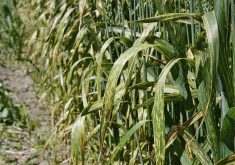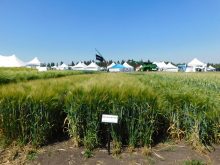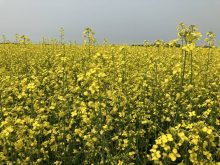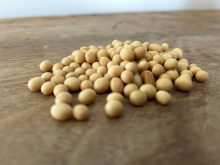A warm winter, interrupted by at least one deep freeze, presents challenges for crop storage so diligence is required, said a crops market analyst with the Alberta government.
Aerate and turn stored crops while monitoring grain bin moisture and temperature, especially when outside temperatures fluctuate, wrote Neil Blue in a recent news release.
“Several cases of spoiling crops have showed up lately, leading to marketing difficulty and large price discounts. Perhaps the mostly warm temperatures this winter and the January period of record cold temperatures have been a factor.”
Read Also

Scouting for disease in canola crops
Inspecting your canola fields for early signs of disease can save you plenty of headaches in the long run.
Manitoba has similar problems, said Anne Kirk, cereal crop specialist with Manitoba Agriculture.
“We have definitely heard of some issues with canola having some heating in the bin and some higher moisture zones,” she said. “That’s something that farmers definitely need to be on the lookout for.”
Kim Stonehouse, crops extension specialist with the Saskatchewan Agriculture, wrote in an email that few problems have been noted in her province.
Spoilage in bins is usually caused by moisture migration.
“In the fall and winter, grain in the bin cools because it’s colder on the edges. Cooling causes that air to become heavier so it settles towards the bin floor,” Kirk said.
“As it moves towards the floor of the bin and into the centre, (the air) becomes warmer because the grain on the inside of the bin is warmer, and then that warmer air becomes lighter.”
That warm air rises in the centre of the bin and cools again when it reaches the cold grain near the surface.
“So what results is an increase in moisture content near the surface, which can cause rapid grain spoilage.”
After storage, grain and oilseeds will respire for a month or more, added Blue.
“This respiration can release moisture, which in turn can lead to spoilage. Dense crops like canola are particularly subject to storage problems, although all crops with moisture can spoil.”
Producers’ best bet is to aerate binned crops during the respiration period. This can reduce or eliminate spoilage.
At this point most growers have had crops in their bins for months. What happens when temperatures go from unseasonably warm to bone-chilling cold over a short time?
That requires a timely bin check, said Kirk.
“Do you have a high moisture zone? Is your grain kind of crusty on top, which indicates higher moisture? What temperatures are you going to add?”
Cycling can equalize temperatures in the bin.
“Especially for something like canola, take a load or part of a load out of a variety of canola bins to just check it and then cycle it through so you are mixing it up a bit and not creating those really high moisture results in the bin,” Kirk said.
Blue also recommends turning the crop. It’s better to do this when it’s cold outside. However, spring may call for another bin turning.
“If continued safe storage is questionable, it may be advisable to turn the grain again in the spring as the stored grain warms. Or use the fan if the bin is equipped,” said Blue.
Consistent monitoring is key, he added.
“Many producers use in-bin monitoring systems to detect potential storage trouble. While lower than last crop year’s prices, crop prices are still historically high and worth protecting in storage.”
Monitoring can also be done with a grain probe, said Kirk.
“We like to recommend probing all sides and the centre of the bin with a normal grain probe to check the moisture and the temperature.”
Monitoring is always a good practice, wrote Stonehouse.
“Grain can store for a long period of time if the temperature is kept below five degrees Celsius even if it is out of condition.
“If there is spoilage happening, it is possible that the grain did not cool to below zero degrees Celsius after harvest due to the unusually warm weather we had. In this case, the cold weather could cause … moisture migration.”
Basic management is the same even in the sub -40 C conditions that occurred in January, said Blue. However, there may be more of it.
“The colder January temperatures would further cool the outside portions of the stored crop, possibly leading to more moisture migration from the bottom middle up towards the top where that moisture would meet cold crop, possibly causing condensation there.”
Although 10 per cent moisture (the “dry” moisture standard for canola) is usually sufficient for canola being marketed, its actual temperature in the bin should be lower, said Blue.
“Safe, longer-term storage moisture levels are below eight per cent. If it is binned at high temperatures, canola can even spoil at six per cent moisture.”
The Canadian Grain Commission outlines moisture standards for a number of grains but consumer expectations also play a role.
“Certain markets or contracts may have different moisture level specifications than (the commission’s),” said Blue. “For example, feed barley sold to a domestic feed user is commonly considered to be dry at 15 per cent moisture or less.”
Kirk also recommended CGC resources.
“The Canadian Grain Commission has some good, safe storage guidelines,” she said. “They have a lot of graphs on their website where you can plot out your initial moisture content of your grain and the temperature of the grain going in the bin.”
















